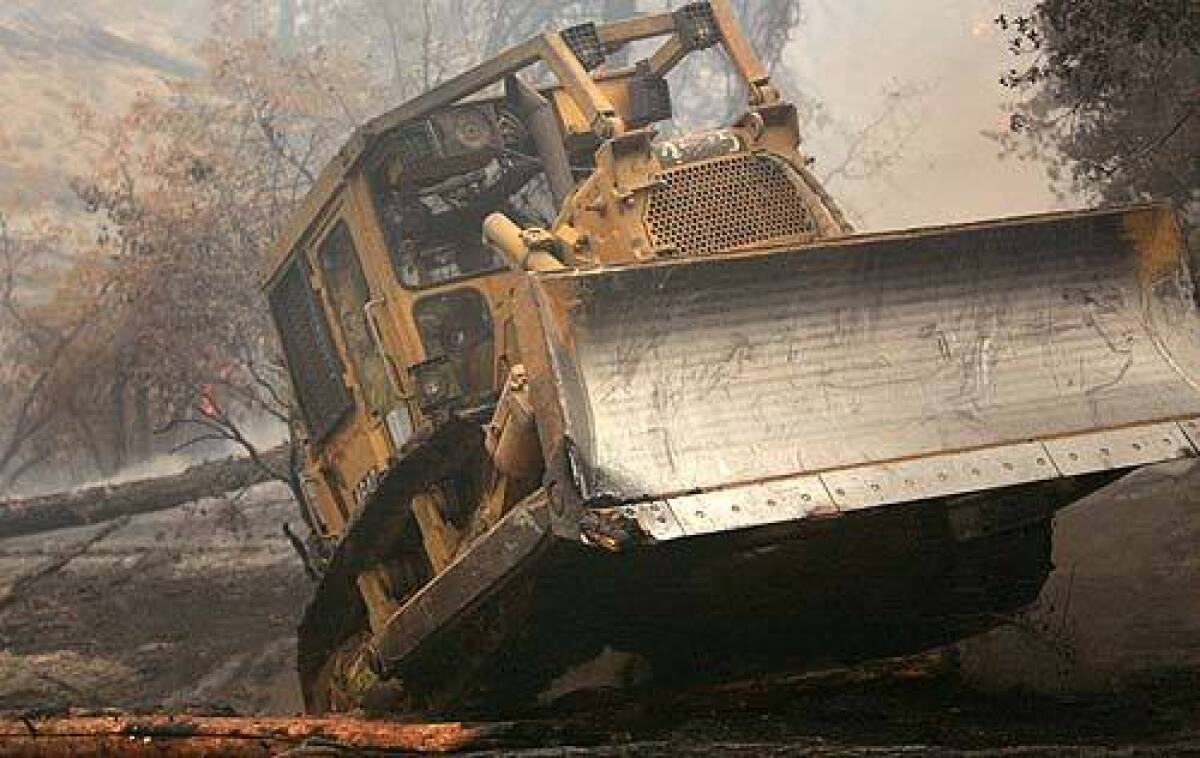A dangerous, and coveted, job on the line

- Share via
Their mission was to save Arrowbear.
And although the winds had flagged Wednesday, the flames that roared out of the backcountry continued their march toward the hamlet in the San Bernardino Mountains, testing the tools, backs and lungs of the Big Bear Hot Shots, a frontline Forest Service crew that fights fires by hand.
When things got desperate, when all the hoeing and shoveling could not stop the fire’s advance, the team called in Chris Ivey and his dead buddy’s bulldozer.
Ivey’s task was to drive the 1960s-vintage, tree-snapping machine into the maw of the blaze, along goat-steep terrain, in blinding smoke and carve out a fire break.
“It’s the most dangerous job in the fire service. What’s not to love about it?” Ivey said as he prepared to climb into the Caterpillar, below a ridge where the fire was leaping up the trunks of pines and oaks.
Barely two weeks ago, his friend and California Department of Forestry and Fire Protection colleague Matt Will was fatally injured along the Big Sur coast while doing much the same thing. He had filled in for Ivey on a firefighting shift, and he was on Ivey’s newer and more comfortable bulldozer when it rolled over. He died Oct. 9.
Ivey was now driving Will’s Cat, delivered by 18-wheeler from Monterey County to the Lake Arrowhead area.
“I’m not happy about it,” he said. “I’m not generally superstitious, but still. . . . Rolling over, that’s what’s on my mind.”
It was midafternoon and the team had been waiting for the dozer for hours. Since early morning, after hiking through ravines through which fire engines could not pass, they had put shoulder to blade to clear leaves and branches from the rocky ground, denying the flames as much fuel as they could.
“This kind of work takes a special person,” said Hot Shots Capt. Paul Cerda, his face streaked with soot and sweat, a chain saw slung across his back.
He and a half dozen of his crew were standing between banks of fire and a vacation house that so far had been spared. A tree exploded, and the eruption of black smoke turned day to night. Flames blew up at the firefighters like curtains lifted by a flung-open door. The Hot Shots stepped back, coughed, righted their axes and pressed on.
Shouts echoed on the mountainside: Watch out -- there are fire whirls here! More water! Just hold those corners! Water coming!
“I got a brother-in-law who’s a Navy SEAL, and he just got back from Iraq,” Cerda said. “I think he’s crazy, but he thinks I’m crazy.”
The crew superintendent, Jim Avala, used a jagged-edged hoe to scrape away leaves and embers. He had been worried about the winds changing course. On this roller-coaster landscape, things could get out of hand quickly.
“You’ve got the community of Arrowbear over there,” he said, jabbing a gloved hand in the direction of Green Valley Lake Road, beyond a stand of smoldering pines. “We’d rather fight this out here than over there in the structures.”
That’s why they needed Ivey.
The large, athletic 37-year-old was awaiting word to unchain the yellow dozer from the flatbed and charge into the fire. Despite its risks -- or maybe because of them -- the job is highly coveted in the firefighting world, Ivey said.
He nodded at two contract bulldozer operators, who were leaning on the flatbed. They would be following Ivey, mopping up.
“These guys would love to have my job,” Ivey said. “Wouldn’t you?”
“Yes,” said Cassidy Johnson.
“Yes,” said Bryce Nason.
“They say operators are a different breed,” said Ivey, who has been driving a dozer for the forestry agency for two years. He motioned toward an impenetrable cloud of smoke up the hill. “I’ll be going right into that.”
He said he had never rolled over, but “I’ve come close to it a whole bunch of times. There’s the law of gravity, and you can’t get around it.”
The other hazards include becoming disoriented in the smoke, getting burned and launching a “widow maker” by bumping the wrong tree.
“There’s a widow maker,” he said, pointing toward a spire of dead trunk atop a 50-foot pine. It could break off, he explained, and come rocketing down, spearing him.
“It’s an exciting job,” he said. “But I wish the fire season was over. . . . This thing with Matt.” His voiced trailed off.
A few minutes later, he was nosing down a near-vertical slope, toward the Hot Shots. The bulldozer creaked, rumbled and whined as it shoved chunks of the mountain out of the way. It crunched flaming logs and left a wake of upturned earth that the crew could defend and fire engines traverse.
“Dozers are our friends,” said Keith Hughes, leader of a forest service strike team whose trucks followed Ivey to the front line, bringing hoses and water.
The dozer could be heard grinding along in defense of Arrowbear.
But it was no longer visible as Ivey navigated it over another ridge, through a narrow passage between steaming boulders and blackened trees, and into the smoke.
More to Read
Sign up for Essential California
The most important California stories and recommendations in your inbox every morning.
You may occasionally receive promotional content from the Los Angeles Times.






![Vista, California-Apri 2, 2025-Hours after undergoing dental surgery a 9-year-old girl was found unresponsive in her home, officials are investigating what caused her death. On March 18, Silvanna Moreno was placed under anesthesia for a dental surgery at Dreamtime Dentistry, a dental facility that "strive[s] to be the premier office for sedation dentistry in Vitsa, CA. (Google Maps)](https://ca-times.brightspotcdn.com/dims4/default/07a58b2/2147483647/strip/true/crop/2016x1344+29+0/resize/840x560!/quality/75/?url=https%3A%2F%2Fcalifornia-times-brightspot.s3.amazonaws.com%2F78%2Ffd%2F9bbf9b62489fa209f9c67df2e472%2Fla-me-dreamtime-dentist-01.jpg)




